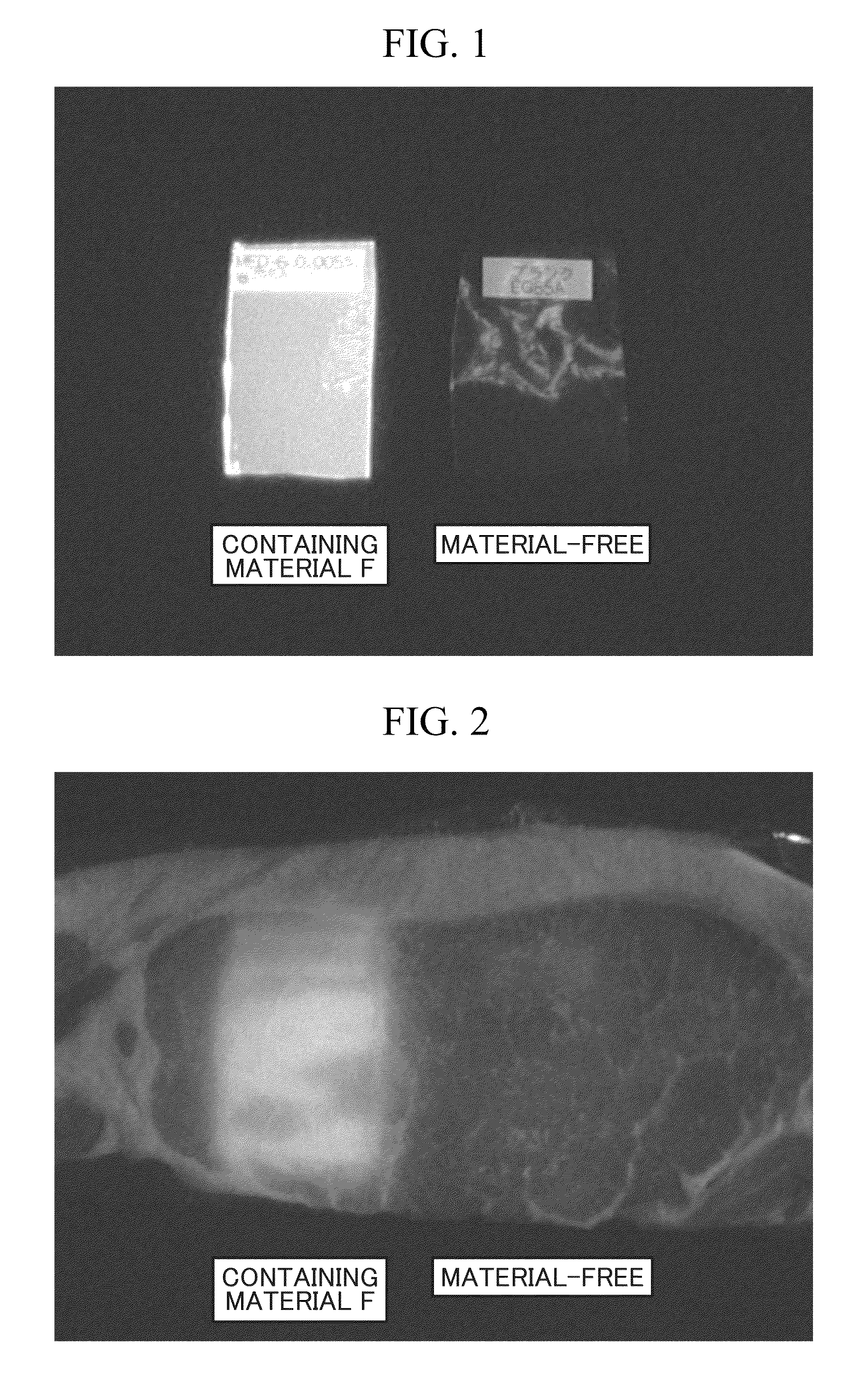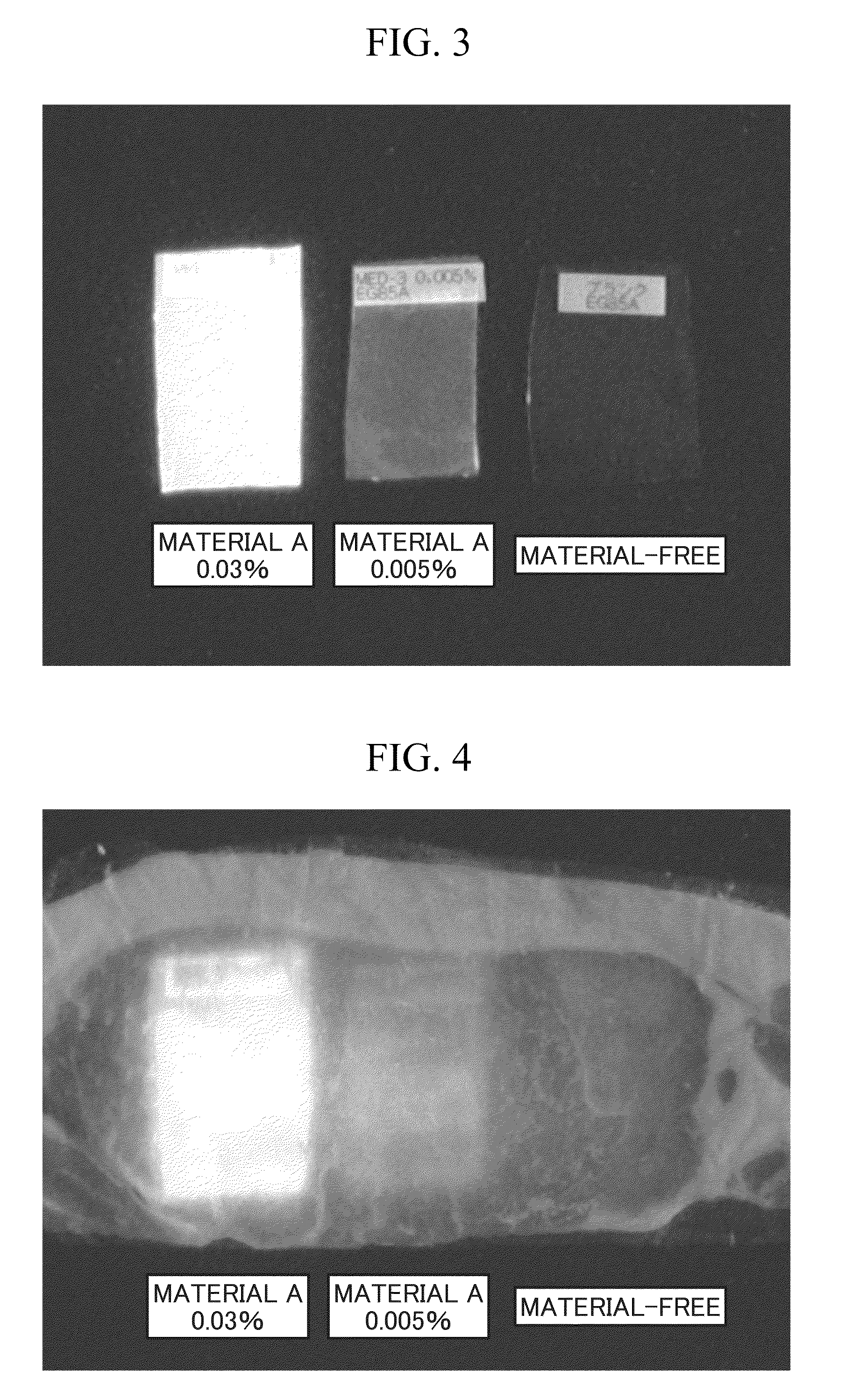Resin composition and molded article
a technology which is applied in the field of resin composition and molded article, can solve the problems of high cost, large amount of raw materials, and large quantity of rare earth elements, and achieve the effects of strong emission intensity, excellent heat resistance and emission quantum yield
- Summary
- Abstract
- Description
- Claims
- Application Information
AI Technical Summary
Benefits of technology
Problems solved by technology
Method used
Image
Examples
preparation example 1
Synthesis of Near Infrared Fluorescent Material A
[0257]Under argon stream, 4-methoxyphenyl boronic acid (2.99 g, 19.7 mmol) was put into a 500 mL three-neck flask, then, this was dissolved in toluene (120 mL), and [1,1′-bis(diphenylphosphino)-ferrocene]palladium (II) dichloride-dichloromethane complex (1:1) (100 mg), 30 mL of ethanol, 5-bromo-2-furaldehyde (3.46 g, 19.8 mmol), and a 2 mol / L sodium carbonate aqueous solution (20 mL) were added thereto, followed by stirring at 80° C. for 14 hours. After the reaction ended, the organic phase was washed with water and a saturated saline solution and dried over anhydrous sodium sulfate, then, the desiccant was separated by filtration, and the solvent was concentrated under reduced pressure. The obtained crude product was separated and purified by flash silica gel chromatography (eluent: hexane / ethyl acetate=19 / 1→4 / 1), whereby 5-(4-methoxyphenyl)-furan-2-carbaldehyde (a-1) was obtained as a pale yellow liquid (obtained amount: 3.39 g, yie...
example 1
[0263]TPU pellets (Tecoflex EG85A, manufactured by Lubrizol Corp.) (100 g) and a near infrared fluorescent material A (5 mg) synthesized in Preparation Example 1 were mixed, and the mixture was attached to the pellet surfaces.
Next, the pellets were put into Labo Plastomill, and melt-kneaded (kneading) at a set temperature of 190° C. for 10 minutes. Thereafter, the kneaded material-containing resin was taken out, and made to be a film.
[0264]The film was obtained in the following manner. First, the material-containing resin was heated for 5 minutes while being sandwiched between iron plates heated to 200° C., and pressed at 5 to 10 mPa while the steel plates were cooled.
[0265]The absorption spectrum of the obtained film was measured using an ultraviolet visible near infrared spectrophotometer “UV3600” manufactured by SHIMADZU Co., and when the emission spectrum was measured using an Absolute PL quantum yields measurement system “Quantaurus-QY C11347” manufactured by Hamamatsu Photonic...
example 2
[0266]In Example 1, a material-containing resin was obtained in the same manner as in Example 1 except that PP pellets (product name: PC630A, manufactured by SunAllomer Ltd.) were used instead of the TPU pellets, PP pellets (100 g) and the near infrared fluorescent material A synthesized in Preparation Example 1 (10 mg) was mixed, and the material was attached to the pellet surfaces. The obtained material-containing resin made to be a film. The fluorescent spectrum of the obtained film was measured in the same manner as that of Example 1, the maximum fluorescent wavelength was 810 nm, and the fluorescent quantum yield was 24%. In addition, the visibility of the film in the near infrared fluorescent detection camera was high.
PUM
| Property | Measurement | Unit |
|---|---|---|
| Nanoscale particle size | aaaaa | aaaaa |
| Wavelength | aaaaa | aaaaa |
| Wavelength | aaaaa | aaaaa |
Abstract
Description
Claims
Application Information
 Login to View More
Login to View More - R&D
- Intellectual Property
- Life Sciences
- Materials
- Tech Scout
- Unparalleled Data Quality
- Higher Quality Content
- 60% Fewer Hallucinations
Browse by: Latest US Patents, China's latest patents, Technical Efficacy Thesaurus, Application Domain, Technology Topic, Popular Technical Reports.
© 2025 PatSnap. All rights reserved.Legal|Privacy policy|Modern Slavery Act Transparency Statement|Sitemap|About US| Contact US: help@patsnap.com



